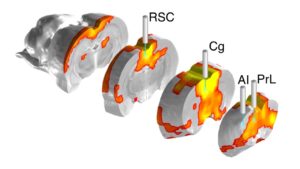Researchers from the UNC School of Medicine, led by Ian Shih, PhD, Professor and Vice Chair of Neurology and Associate Director of the Biomedical Research Imaging Center, revealed the role of the insular cortex in controlling the Default Mode Brain Network.

When we daydream or revisit memories, a large group of regions within our brain “lights up,” or becomes more active. It’s referred to as the Default Mode Network (DMN) because it is more active when the brain is not focused on the outside world.
Numerous brain disorders, including Alzheimer’s, attention-deficit/hyperactivity disorder, and mood disorders, have been linked to issues with the DMN. However, the neurophysiological basis of the DMN is not well understood.
Neuroimaging techniques, like functional magnetic resonance imaging (fMRI), are not able to directly measure neuronal activity. To address this knowledge gap, a research team led by Ian Shih, PhD, professor and vice chair of the Department of Neurology and associate director of the Biomedical Research Imaging Center, has created a novel experimental platform that is able to optically record local neuronal activity during brain-wide fMRI in rodents.
“We hope that this work will pave the way for future translational studies aimed at controlling large-scale brain networks,” said Shih. “This could help design network-based treatment regimens for many neurological and neuropsychiatric disorders.”
The study, which was published in the journal Science Advances, examined the dynamic activity of DMN-related brain regions and analyzed them with a variety of computational approaches.
The DMN is one of our brain’s large-scale brain networks. When we first learn about the brain, we are taught that each part of the brain has a distinct function. But the reality is that many brain areas activate and deactivate together during behavior and cognition, and form large-scale brain networks, much like a team.
Neuroscientists are becoming more interested in these large-scale networks as they learn that certain cognitive tasks are dependent upon “functionally connected” brain regions. When a person is awake and at rest, like when they are daydreaming, retrieving memories, or envisioning the future, the DMN is active.
However, it is challenging to obtain the neuronal data necessary to understand dynamic DMN activity in human subjects, so Shih and team turned to an animal model to study the network, in which putative DMN-related brain regions have been identified.

“We used a rodent model, where genetically encoded calcium sensors were expressed in neurons,” said first author Tzu-Hao Harry Chao, PhD, who built and validated this experimental platform in the Shih lab. “This allowed us to record neuronal activity in multiple DMN-related brain regions by detecting changes in fluorescence via optical fibers without interfering with the measurement of fMRI signals.”
Fiber photometry uses fiber optics to deliver certain wavelengths of light to excite fluorescent proteins responsive to that wavelength and record activity-dependent light emission. Through this process, scientists can directly measure activity from specific population of cells or neurochemicals within a specified location of the brain.
Using this novel experimental platform, Chao and colleagues demonstrated that activation of one area of the brain—the anterior insular cortex—is associated with suppressing, or “turning off,” the Default Mode Network.
In the human brain, the insular cortex is found in the cortex and is “insulated” by the frontal, parietal, and temporal lobes. The insula is responsible for several important functions in the brain, including processing our five senses, controlling hand-eye coordination, and self-awareness. The insula also plays a critical role in social and addiction-related behaviors.
“This is important neuronal evidence highlighting the role of the anterior insular cortex in controlling DMN activity,” Shih explained.
In collaboration with Vinod Menon, PhD, another senior author and professor of the Department of Psychiatry & Behavioral Sciences at Stanford University, the research team further used advanced computational approaches to identify the brain states and information flow during these conditions.
The team also discovered that the prelimbic area of the rodent cortex alternates its synchronization with the DMN and anterior insular cortex, which suggests that the prelimbic cortex in the rodent brain could also play a role in the salience network – another large-scale brain network important for attention, sensory processing, and goal-directed behavior.
The authors built the multi-channel spectral fiber photometry system using Research Infrastructure Equipment Allocation awarded to the Department of Neurology in 2018-19. Additional authors of the work include Li-Ming Hsu (co-first author), Domenic Hayden Cerri, Wei-Ting Zhang, and Tzu-Wen Wang of UNC-Chapel Hill; Byeongwook Lee (co-first author) and Srikanth Ryali of Stanford University.
This research was supported mainly by the National Institute of Mental Health (R01MH126518). Shih is also a member of the UNC Bowles Center for Alcohol Studies, the UNC Intellectual and Developmental Disabilities Research Center, the UNC McAllister Heart Institute, and the UNC-NCSU Joint Department of Biomedical Engineering.
The techniques used in this work are available to other researchers. Contact camri@unc.edu if you are interested in the Core Facility service.
Media contact: Kendall Daniels, Communications Specialist, UNC Health | UNC School of Medicine